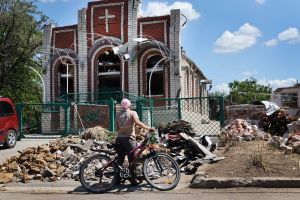Hawaii Volcano Activity Updates: Toxic Ash Emissions, Earthquakes to Continue
The USGS Hawaiian Volcano Observatory issued a warning for those living in the Big Island after the ongoing eruption of Mt. Kilauea continues to emit toxic ashes and earthquakes in the island.
On Wednesday, May 16, the volcano dispersed a toxic cloud that reached 12,000 feet up in the air, leading to the declaration of code red to warn the aviation industry against flying over the island for its possible eruption anytime soon. Then, a magnitude 4.4 earthquake shook the main caldera of the volcano, causing damages to roads and properties within Hawai'i Volcanoes National Park.
While the code red warning seemed to be staying for a while, USGS volcanologist Michelle Coombs mentioned in a video statement that the threat is very immediate.
"It sounds a little bit alarming," Coombs stated in the video. However, the "code red" warning is just meant to say that air travel across the island could be hazardous. "It doesn't mean that a really big eruption is imminent," she also said, adding, "It's really just characterizing that aviation situation."
Meanwhile, the shaking in the ground should be expected to continue after the lava column found within the main caldera of Mt. Kilauea has been dropping consistently. This causes the frequent earthquakes around the area.
"As deflation continues, strong earthquakes in the area around Kilauea Volcano's summit are expected to continue and may become more frequent. Areas further from these earthquakes may feel some ground motion as well, but much less severe," the statement from USGS reads.
Since the earthquakes have shallow depth, this means that it can cause more damage to the nearby area of the region.
But despite the latest volcanic activity, experts believe that the incidents were not the "big one" that they are predicting. Instead, these are just some of the volcano's way to relieve some pressure.
The ongoing activity of Mt. Kilauea started on May 3, were lava fountains discharged volcanic materials 300 feet up in the air. It also caused lava flows and released volcanic gases in the residential area of Leilani Estates, preceded by numerous earthquakes and cracks on the road. As much as 1,700 residents were also forced to evacuate from Leilani Estates and Lanipuna Gardens subdivisions.
Aside from the lava flows, the National Weather Service released a statement Wednesday regarding the potentially dangerous air quality brought by the ash fall and volcanic smog that came from Kilauea. They also advised those who are located in the area to avoid unnecessary exposure to ash since it can be both an eye and respiratory irritant. They also mentioned that individuals with respiratory sensitivities should practice extra precaution to lessen their exposure to the toxic gases.
In another news, Hawaii News Now revealed that volcanic experts debunked earlier speculations that the upcoming big eruption from Mt. Kilauea could cause the same damages as the highly destructive Mt. Helens eruption that happened in 1980. Instead, it could be similar to the events that happened in 1924 when Kilauea released rocks on the crater floor and expelled columns as high as 20,000 feet.





























